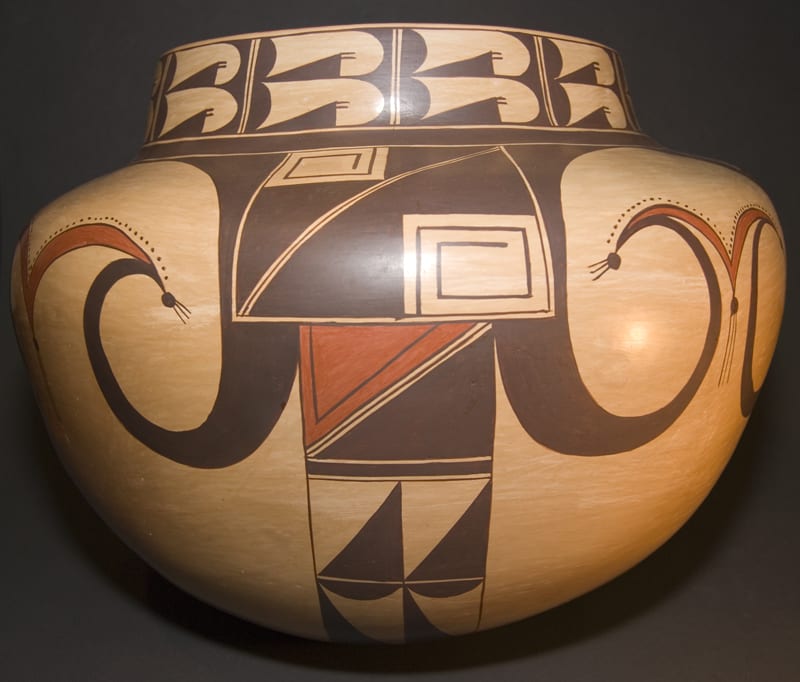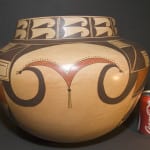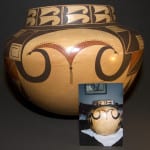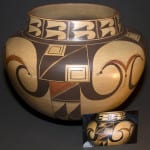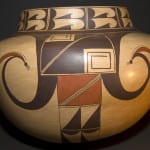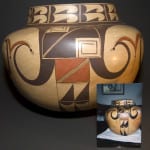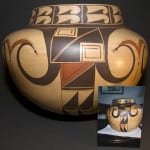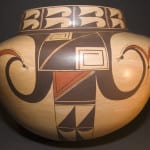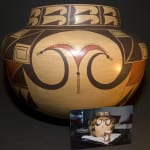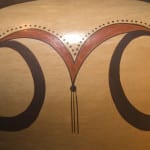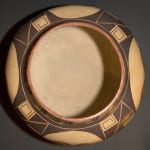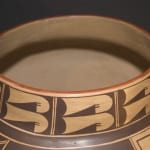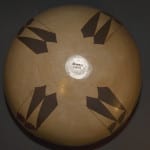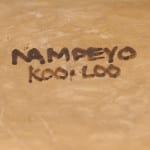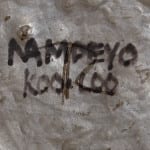This huge Hopi-Tewa polychrome jar has a decorated rim and an eagle-tail design modified by the addition of elegant red swags between the curvilinear “feathers.” The pot is accurate both in size and in decoration to an “Old Lady” Nampeyo pot given on March 1, 1907 to the great grandmother of Dorothy Wagar of Albuquerque. Pot 2007-17 is scratch-signed “RS” with the addition of a painted signature “Nampeyo Koo Loo” (Nampeyo, Corn Clan). The jar is not quite symmetrical, being 12.88” in height and from varying from 16.31” to 17.31” in width. The original pot is almost exactly the same height, (12.5”) but is slightly narrower, at about 14.0” width. The images show Rachael’s pot with smaller photographs I took of the original Nampeyo pot in Dorothy Waggar’s home.
Dorothy’s daughter Fay Lackey contacted me through the collection website in April 2005 with pictures of her pot asking for any information I might have that would identify the maker. The eagle-tail motif, the spontaneous painting of the design, and use of background space were clear indications that this was indeed an “Old Lady” Nampeyo pot. In July of 2005, I visited the pot (and the Wagar/Lackey family) in Albuquerque, NM, and took a series of pictures. I put the family in touch with Ed Wade and, in October 2005, they sold the jar to him. [Photographs and documentation of the provenance of the older pot are on file with 2007-17.] Ed sold the jar to Allan Cooke and it is now part of the Cooke Collection at The Museum of the West, Scottsdale. Allan had the pot slightly restored, see pot #41 in Wade and Cooke, 2012:168-171.
The red rim, an unusual feature on Sikyatki revival ware, is a holdover from the typical red rim of 19th century Polacca ware, and (as on 2003-10) is likely an indication of a manufacture date for the original jar that was close to the turn of the century. Kramer (1996:184-185, Fig. B & C) has determined that the rectangle with diagonal and frets seen on the original Nampeyo jar was used for a short period between 1904-1910—sometimes in conjunction with the eagle tail design (as on 2007-17). I have a turn-of-the-century catalogue from the Francis E. Lister trading company of Mesilla Park, NM. A listing of “Moki” pottery shows ten pots—four are by Nampeyo (Francis E. Lester Co.,1907:65). The largest (13 X 15 inches) has the same general shape as 2007-17 and carries the eagle-tail design, though probably without swags. It is not listed as a Nampeyo pot and is priced at $10.00. Although the catalogue is undated, testimonials included in the text are dated as recently as 1906. Considered together, this evidence points to a production date of 1904-1907 for the original Nampeyo jar. The shape of 2007-17 (and the original Nampeyo jar) is very similar to the shape of a large Nampeyo pot in the collection of the Museum of Indian Arts and Culture in Santa Fe, NM (see Kramer, 1996:150).
As detailed in the discussion of 2005-16 in Appendix C, pottery by Nampeyo often has several characteristic features: 1) A tension between linear and curvilinear elements, typically represented as a contrast between heavy and delicate elements, 2) A deliberate asymmetry of design, 3) The use of color to integrate design elements, and 4) The use of empty (negative) space to frame the painted image.
The design on 2007-17 is a variation of the classic “eagle-tail” motif Nampeyo used on 2005-16 and thus shares these four design features:
First, the curved black “wing” elements thrust up while the linear “tail” elements draw the eye down. The red swags contradict this division since they are curvilinear but attract the eye downward. Substantial energy is thus created by the alternate direction of these three elements. As the pot rotates, the swag draws the eye down, the wings force the eye up, and the linear tail then draws the gaze down. As on 2005-16, this “down/up” pattern is repeated eight times as the pot rotates. Because the red swags on 2007-17 are a more emphatic element than the two delicate perpendicular lines between the “wings” on 2005-16, the overall design of 2007-17 is bolder and the tension more dramatic than the design of 2005-16. Moreover, two rows of horizontal design on the neck of the jar contradict the vertical energy generated by the elements on the body of 2007-17, which adds to the design tension.
Second, although there is repetition of design on 2007-17, there are also two patterns of asymmetry. Similar to 2002-03, a series of about 50 dots above each red swag create imbalance. In addition, the red elements in the linear tails alternate between a single triangle and two triangles forming a square. (Note that the tail red elements on the original Nampeyo pot do not alternate as regularly as on 2007-17, Rachel’s copy.)
Third, the design of 2007-17 is largely monochromatic, with just three areas of red. The red swags floating in space are the focal element of the overall design. Because the swags and red triangle/squares in the tails are at the same longitude, one’s eye is first pulled to focus on the swags and then sees alternating red designs interspersed by black “wings” as the pot turns. Red curvilinear areas alternate with red linear areas. The red edge of the lip visually links to the red on the body of the jar, thus unifying the body of the jar with its neck.
Finally, as on 2005-16, much of the lower half of 2007-17 is left undecorated; this negative space highlights the more-decorated upper half. Indeed, there is almost a perfect gradient of design density from the densely decorated neck of the jar to its almost plain bottom. The red swags make this a unique variation of the eagle-tail design Nampeyo used throughout her painting career. The curved red design rests on the curved black wings; the plain space between them thus forms a third curvilinear image. The upward thrust of all three pulls the viewer’s eye upward and toward the linear tail motif. The downward flow of the tasseled swag and the empty space above it counterbalance this tension. These contradictory tensions give the overall design unique energy and elegance, a visual impact that depends on the complex pattern of negative space around the swags. Using elegant swags not only to focus and integrate the overall design, but also to provide upward and downward energy, is a singular achievement—even for Nampeyo.
It is interesting to compare the original Nampeyo jar with the “copy” by her great, great granddaughter. Nampeyo’s pot has a larger base and sits firmly on a surface. Rachel’s pot has a much narrower base that expands into the body of the jar. As a result, the newer pot seems to float and is visually lighter. Since Rachel’s pot is not perfectly symmetrical, however, it is also less steady than the older pot.
The painting of Nampeyo is more impulsive than that of her descendent. On both pots, there is considerable variation in the size, thickness, and orientation of the red swags. It seems that these are the last elements drawn into the design and whatever variation there is in shape or placement of the black eagle tails is magnified by the swags that bridge the tails. It is precisely these variations that give both the old and new versions energy and character.
To my eye, the perfectly drawn decoration on much of the “high end” modern First Mesa pottery seems like a stencil and gives even the most energetic design a static character. The variations in the swags on Rachel’s pot are much less than those on the pot of her great-great grandmother, but they are still quite evident. Nampeyo made additional “mistakes” when drawing the linear tail design, adding unneeded lines and alternating the four tails irregularly. Rachel made no such “errors.” Nevertheless, both the old and new versions of this pot incorporate the same spirit and beauty.
The collection is particularly rich in pots by Priscilla’s daughters (Rachel, Jean, and Nyla) because it seems to me that they are particularly able to combine great skill and yet preserve enough irregularity to give their pots energy and uniqueness. For me, this is the attraction of objects of handmade beauty—a beauty that in 2007-17 spans five generations of the Nampeyo family.
For other pots in the collection by Rachel, and sisters Jean and Nyla, see the Artist List.
In July 2007, I visited Rachel Sahmie in her home near First Mesa and showed her enlargements of my photographs of the “Old Lady” pot. She had never seen this modification of the eagle-tail design before. She was excited by the image and was willing to try making a reproduction of her great grandmother’s pot. 2007-17 is the result. Subsequent to creating 2007-17, Rachel has used these design elements on a series of pots that have appeared at auction. (See, for example, a 9.5” h X 9” w jar sold by R.G. Munn auction on 10/19/08. Photograph on file.) In August 2008 (at my request), Rachel delivered a small version of 2007-17 to Dorothy Wagar in Albuquerque. Upon seeing the new pot, Alan Lackey (Dorothy’s son-in-law) exclaimed “It’s come home, and in a smaller, more manageable size!”
Rachel had to make a new piki to form the base and made special large clay “shards” to cover pot 2007-17 during firing. She made two jars of this size before she was satisfied that she had come close to the shape and dimensions of the original.

